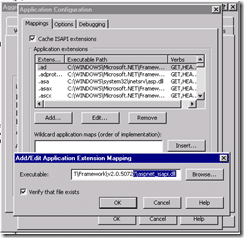Have you ever, when developing a website, been frustrated when you get a different result when you deploy your application to http://site/ and http://site/app/.
I don’t know about you, but it annoys the hell out of me. All that work in CSS and none of your images work when you run it in a different location. This would be especially frustrating when you are running multiple feature branches and need Kerberos interaction. The amount of work required to get Kerberos to work (SPN’s, URL’s, Delegation and AD) limits the number of sites you can have in an enterprise environment.
I have just two. I have a site for the latest candidate release and one to host all of my feature branches. As I am using TFS I identify my Feature with either a Requirement or Change Request Id and name everything after this.
Thus I have http://site/ and http://site-dev/1345. This makes it easy to find and test, and my CI build at the ends of the day just overwrites the previous version.
This means that all of your css like this…
.down {
padding-right:14px;
background: url('/UI/Resources/Images/arrow_down.gif') no-repeat 100% 50%;
}
…will not work in one of your locations 🙁 This makes me sad…
So, in order to cheer up your CSS, you can give it a little bit of .NET Omph…
The first thing you need to do is get .NET to handle ALL of your requests, and not just for the ASP.NET pages.
Add a “Wildcard application mapping” to the “aspnet_isapi.dll” and you are good to go…
To process the css we need an HttpHandler, this is dead easy to implement and action so:
Imports System.Web
Imports System.Text.RegularExpressions
Public Class CssHttpHandler
Implements IHttpHandler
Public ReadOnly Property IsReusable() As Boolean Implements System.Web.IHttpHandler.IsReusable
Get
Return False
End Get
End Property
Public Sub ProcessRequest(ByVal context As System.Web.HttpContext) Implements System.Web.IHttpHandler.ProcessRequest
context.Response.ContentType = "text/css"
'Get the file from the query stirng
Dim File As String = context.Request.FilePath
' Find the actual path
Dim Path As String = context.Server.MapPath(File)
'Limit to only css files
If Not System.IO.Path.GetExtension(Path) = ".css" Then
context.Response.End()
End If
'Make sure file exists
If Not System.IO.File.Exists(Path) Then
context.Response.End()
End If
' Open the file, read the contents and replace the variables
Using css As System.IO.StreamReader = New System.IO.StreamReader(Path)
Dim cssText As String = css.ReadToEnd()
' Replace url's
Dim rximg As New Regex("url('*(.+?)'*)")
For Each m As Match In rximg.Matches(cssText)
cssText = cssText.Replace(m.Groups(1).Value, HandleRootOperator(m.Groups(1).Value))
Next
context.Response.Write("/* Please use the ~ operator in front of all URL's. e.g. url('~/UI/Resources/Images/Image.gif') will be converted at runtime to point at the root of the application. */" & vbCrLf & cssText)
End Using
End Sub
' Methods
Public Function HandleRootOperator(ByVal virtualUrl As String) As String
If Not String.IsNullOrEmpty(virtualUrl) Then
If virtualUrl.StartsWith("^~/", StringComparison.OrdinalIgnoreCase) Then
Return ("^" & Me.applicationPath & virtualUrl.Substring(2))
End If
If virtualUrl.StartsWith("~/", StringComparison.OrdinalIgnoreCase) Then
Return (Me.applicationPath & virtualUrl.Substring(1))
End If
End If
Return virtualUrl
End Function
' Fields
Private applicationPath As String = IIf((HttpRuntime.AppDomainAppVirtualPath.Length > 1), HttpRuntime.AppDomainAppVirtualPath, String.Empty)
End Class
Now add the Handler to you web.config
<httpHandlers> <add verb="*" path="*.css" type="Company.System.Product.CssHttpHandler, Company.System.Product" /> </httpHandlers>
And you are done 🙂


